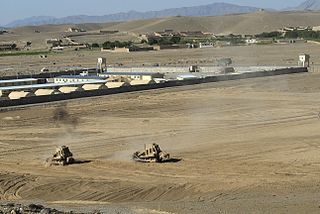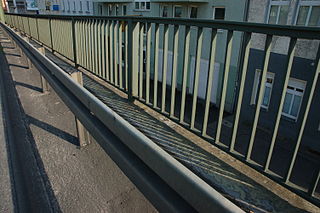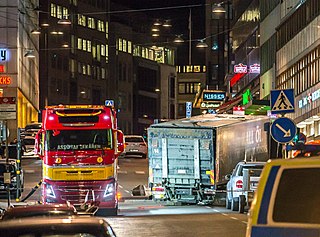
A car bomb, bus bomb, van bomb, lorry bomb, or truck bomb, also known as a vehicle-borne improvised explosive device (VBIED), is an improvised explosive device designed to be detonated in an automobile or other vehicles.

An improvised explosive device (IED) is a bomb constructed and deployed in ways other than in conventional military action. It may be constructed of conventional military explosives, such as an artillery shell, attached to a detonating mechanism. IEDs are commonly used as roadside bombs, or homemade bombs.

A forward operating base (FOB) is any secured forward operational level military position, commonly a military base, that is used to support strategic goals and tactical objectives. An FOB may contain an airbase, hospital, machine shop, and other logistical facilities. The base may be used for an extended period of time. FOBs are traditionally supported by main operating bases that are required to provide backup support to them. A FOB also improves reaction time to local areas as opposed to having all troops on the main operating base.

A bollard is a sturdy, short, vertical post. The term originally referred to a post on a ship or quay used principally for mooring boats. It now also refers to posts installed to control road traffic and posts designed to prevent automotive vehicles from colliding or crashing into pedestrians and structures.

Traffic barriers keep vehicles within their roadway and prevent them from colliding with dangerous obstacles such as boulders, sign supports, trees, bridge abutments, buildings, walls, and large storm drains, or from traversing steep (non-recoverable) slopes or entering deep water. They are also installed within medians of divided highways to prevent errant vehicles from entering the opposing carriageway of traffic and help to reduce head-on collisions. Some of these barriers, designed to be struck from either side, are called median barriers. Traffic barriers can also be used to protect vulnerable areas like school yards, pedestrian zones, and fuel tanks from errant vehicles.
The tactics of terrorism are diverse. As important as the actual attacks is the cultivation in the target population of the fear of such attacks, so that the threat of violence becomes as effective as actual violence. The different tactics that terrorist groups utilize can be very simple to extremely complex.

The Glasgow Airport attack was a terrorist ramming attack which occurred on 30 June 2007, at 15:11 BST, when a dark green Jeep Cherokee loaded with propane canisters was driven at the glass doors of the Glasgow Airport terminal and set ablaze. The car's driver was severely burnt in the ensuing fire, and five members of the public were injured, none seriously. Some injuries were sustained by those assisting the police in detaining the occupants. A close link was quickly established to the 2007 London car bombs the previous day.

The Explosives Division (EXD) is a division of the Science and Technology Directorate of the United States Department of Homeland Security. Within the Homeland Security Advanced Research Projects Agency, EXD develops technologies needed to detect, interdict, and lessen the effect of non-nuclear explosives used by terrorists against mass transit, civil aviation, and critical infrastructure.

Target hardening, also referred to simply as hardening when made clear by the context, is a term used by police officers, those working in security, and the military referring to the strengthening of the security of a building or installation in order to protect it in the event of attack or reduce the risk of theft. It is believed that a "strong, visible defense will deter or delay an attack".
Standoff distance is a security term that refers to measures to prevent unscreened and potentially threatening people and vehicles from approaching within a certain distance of a building, car, or other shelter, roadblock or other location, or to a person such as a law enforcement officer or VIP, or to a friendly area / location.
A terrorist ramming attack occurred on 4 August 2014, when a man drove an excavator type of tractor out of a construction site, injuring several pedestrians and killing one man before ramming the tractor into a public bus, overturning the bus and then hitting it repeatedly. The terrorist was shot dead at the scene by a police officer while still seated at the wheel of the tractor and continuing to attack the bus by swinging the arm of the excavator against it.
On 5 November 2014, in a terrorist ramming attack, a Hamas operative deliberately drove a van at high speed into a crowd of people waiting at the Shimon HaTzadik light rail station in the Arzei HaBira neighborhood of Jerusalem.

A vehicle-ramming attack, also known as a vehicle as a weapon or VAW attack, is an assault in which a perpetrator deliberately rams a vehicle into a building, people, or another vehicle. According to Stratfor Global Intelligence analysts, this attack represents a relatively new militant tactic that could prove more difficult to prevent than suicide bombings.

On 21 December 2014, a Muslim man in the French city of Dijon was arrested after a vehicle-ramming attack in which he drove a van into pedestrians in five areas of the city in the space of half an hour. Thirteen people were injured, two of them seriously.
On 31 May 2017, a truck bomb exploded in a crowded intersection in Kabul, Afghanistan, near the German embassy at about 08:25 local time during rush hour, killing over 150 and injuring 413, mostly civilians, and damaging several buildings in the embassy. The attack was the deadliest terror attack to take place in Kabul. The diplomatic quarter—in which the attack took place—is one of the most heavily fortified areas in the city, with three-meter-high (10 ft) blast walls, and access requires passing through several checkpoints. The explosion created a crater about 4.5 meters (15 ft) wide and 30 feet deep. Afghanistan's intelligence agency NDS claimed that the blast was planned by the Haqqani Network. Although no group has claimed responsibility, the Afghan Taliban are also a suspect but they have denied involvement and condemned the attack. It was the single largest attack on the city up till that point.

On 3 June 2017, a terrorist vehicle-ramming and stabbing took place in London, England. A van was deliberately driven into pedestrians on London Bridge, and then crashed on Borough High Street, just south of the River Thames. The van's three occupants then ran to the nearby Borough Market area and began stabbing people in and around restaurants and pubs. They were shot dead by Metropolitan Police and City of London Police authorised firearms officers, and were found to be wearing fake explosive vests. Eight people were killed and 48 were injured, including members of the public and four unarmed police officers who attempted to stop the assailants. British authorities described the perpetrators as "radical Islamist terrorists".
On 23 June 2017, a series of terrorist attacks took place in Pakistan resulting in 96 dead and over 200 wounded. They included a suicide bombing in Quetta targeting policemen, followed by a double bombing at a market in Parachinar, and the targeted killing of four policemen in Karachi.
On 14 August 2017, an improvised explosive device targeted a Frontier Corps (FC) vehicle in Harnai district of Pakistan's southwestern Balochistan province. The attack left 8 FC troops dead. The Balochistan Liberation Army claimed responsibility for the attack.
On 27 January 2018, an ambulance was used as a vehicle-borne improvised explosive device near Sidarat Square in Kabul, Afghanistan. At least 103 people were killed and 235 others wounded in the attack. The Taliban claimed responsibility for the attack.

The 2019 Tokyo car attack was a vehicle-ramming attack that occurred on January 1, 2019, in Tokyo, Japan. 21-year-old Kazuhiro Kusakabe told authorities he intentionally rammed into pedestrians crowded into narrow Takeshita Street in Harajuku district as a terrorist attack in retaliation for the execution of Aum Shinrikyo doomsday cult members. The New Year's Day attack left eight injured. A ninth person was also directly injured by the driver. Kusakabe said he initially planned an arson attack by spreading kerosene with a high-pressure washer at the crowd at the nearby Meiji Shrine but found that vehicles were not permitted there.















